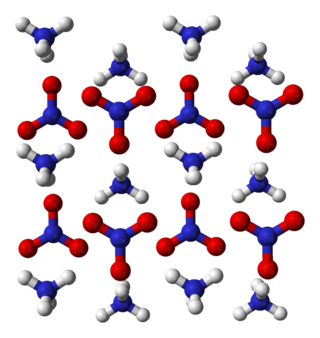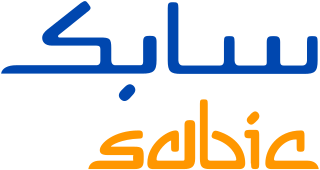Urea, also known as carbamide, is an organic compound with chemical formula CO(NH2)2. This amide has two amino groups joined by a carbonyl functional group. It is thus the simplest amide of carbamic acid.

A fertilizer or fertiliser is any material of natural or synthetic origin that is applied to soil or to plant tissues to supply plant nutrients. Fertilizers may be distinct from liming materials or other non-nutrient soil amendments. Many sources of fertilizer exist, both natural and industrially produced. For most modern agricultural practices, fertilization focuses on three main macro nutrients: nitrogen (N), phosphorus (P), and potassium (K) with occasional addition of supplements like rock flour for micronutrients. Farmers apply these fertilizers in a variety of ways: through dry or pelletized or liquid application processes, using large agricultural equipment or hand-tool methods.

Ammonium nitrate is a chemical compound with the chemical formula NH4NO3. It is a white crystalline salt consisting of ions of ammonium and nitrate. It is highly soluble in water and hygroscopic as a solid, although it does not form hydrates. It is predominantly used in agriculture as a high-nitrogen fertilizer. Global production was estimated at 21.6 million tonnes in 2017.

Melamine is an organic compound with the formula C3H6N6. This white solid is a trimer of cyanamide, with a 1,3,5-triazine skeleton. Like cyanamide, it contains 67% nitrogen by mass, and its derivatives have fire retardant properties due to its release of nitrogen gas when burned or charred. Melamine can be combined with formaldehyde and other agents to produce melamine resins. Such resins are characteristically durable thermosetting plastic used in high pressure decorative laminates such as Formica, melamine dinnerware, laminate flooring, and dry erase boards. Melamine foam is used as insulation, soundproofing material and in polymeric cleaning products, such as Magic Eraser.

Koninklijke DSM N.V., is a Dutch multinational corporation active in the fields of health, nutrition and materials. Headquartered in Heerlen, at the end of 2017 DSM employed 21,054 people in approximately 50 countries and posted net sales of €8.632 billion in 2018 and €9.204 billion in 2021.

Sindri is a neighbourhood in Dhanbad in Dhanbad Sadar subdivision of Dhanbad district in Jharkhand state, India.

Saudi Basic Industries Corporation, known as SABIC, is a Saudi chemical manufacturing company. 70% of SABIC's shares are owned by Saudi Aramco. It is active in petrochemicals, chemicals, industrial polymers, fertilizers, and metals. It is the second largest public company in the Middle East and Saudi Arabia as listed in Tadawul.
In China, the adulteration and contamination of several food and feed ingredients with inexpensive melamine and other compounds, such as cyanuric acid, ammeline and ammelide, are common practice. These adulterants can be used to inflate the apparent protein content of products, so that inexpensive ingredients can pass for more expensive, concentrated proteins. Melamine by itself has not been thought to be very toxic to animals or humans except possibly in very high concentrations, but the combination of melamine and cyanuric acid has been implicated in kidney failure. Reports that cyanuric acid may be an independently and potentially widely used adulterant in China have heightened concerns for both animal and human health.

Mangalore Chemicals & Fertilizers Limited is the largest manufacturer of chemical fertilizers in the state of Karnataka, India. The company is part of the Adventz Group. The company's corporate and registered office is at UB City, Bangalore and its factory unit is in Panambur, north of Mangalore.
Coffeyville Resources, formerly known as the COOP Refinery, is a company which owns an oil refinery in Coffeyville, Kansas. The refinery is owned and operated by Coffeyville Resources Refining & Marketing. The refinery employs about 500 people and produces approximately 2,100,000 US gallons (7,900,000 L) of gasoline per day, and 1,700,000 US gallons (6,400,000 L) of middle distillates per day, predominantly diesel oil.
Borealis AG is an Austrian chemical company and is the world's eighth largest producer of polyethylene (PE) and polypropylene (PP). It is headquartered in Vienna, Austria.

Andrey Igorevich Melnichenko is a Russian billionaire entrepreneur. He is the founder and ex-beneficiary of fertilizer producer EuroChem Group and coal producer SUEK, and was a non-executive director in both companies until 9 March 2022.

A controlled-release fertiliser (CRF) is a granulated fertiliser that releases nutrients gradually into the soil. Controlled-release fertilizer is also known as controlled-availability fertilizer, delayed-release fertilizer, metered-release fertilizer, or slow-acting fertilizer. Usually CRF refers to nitrogen-based fertilizers. Slow- and controlled-release involve only 0.15% of the fertilizer market (1995).
Urea (46-0-0) accounts for more than fifty percent of the world's nitrogenous fertilizers. It is found in granular or prill form, which allows urea to be easily stored, transported and applied in agricultural settings. It is also the cheapest form of granular nitrogen fertilizer. Since urea is not an oxidizer at standard temperature and pressure, it is safer to handle and less of a security risk than other common nitrogen fertilizers, such as ammonium nitrate. However, if urea is applied to the soil surface, a meaningful fraction of applied fertilizer nitrogen may be lost to the atmosphere as ammonia gas; this only occurs under certain conditions.

Fauji Fertilizer Company Limited (FFC) is a Pakistani chemical company which produces chemical fertilizer. It was established by the Fauji Foundation which holds a controlling interest. FFC produces or markets various fertilizers which include urea, DAP, SOP, MOP, Boron and Zinc.

Maire Tecnimont S.p.A. is an Italian group numbering 50 operating companies in the engineering, technology and energy sectors. It deals in plant engineering in oil and gas, chemicals and petrochemicals, in green chemistry and in technology supporting energy transition.
Mekog was a chemical company founded 1928 that manufactured fertilizer using hydrogen from coke oven gas as a feedstock. The company's facilities were located on the site of the Koninklijke Nederlandsche Hoogovens en Staalfabrieken steelworks near IJmuiden in the Netherlands.
EuroChem Group AG is a Swiss fertilizer producer. It is a fertilizer manufacturer with its own capacity in all three primary nutrients – nitrogen, phosphates and potash. It is headquartered in Zug, Switzerland.

Grupa Azoty Zakłady Azotowe "Puławy" PLC is a Polish chemical company based in Puławy, Lublin Voivodeship, specializing in the production of mono-volumes of nitrogen fertilizer, one of the world's largest producers of melamine. It also produces caprolactam, hydrogen peroxide, AdBlue and technical gases.

The Brunei Fertilizer Industries (BFI) is a government owned company and producer of ammonia and urea granular fertilizer, located in Sungai Liang Industrial Park (SPARK), Belait District, Brunei. It is claimed to be one of the largest fertilizer facilities in Southeast Asia, and has a production capacity of 1,365,000 tonnes of urea annually. The facility for BFI started being built in May 2018 and 500 jobs was expected be created when the plant is fully operating.













